Explore the Art of Andhra Pradesh, India’s Art Capital, where age-old traditions meet contemporary creativity, to showcase exquisite craftsmanship and vibrant heritage.
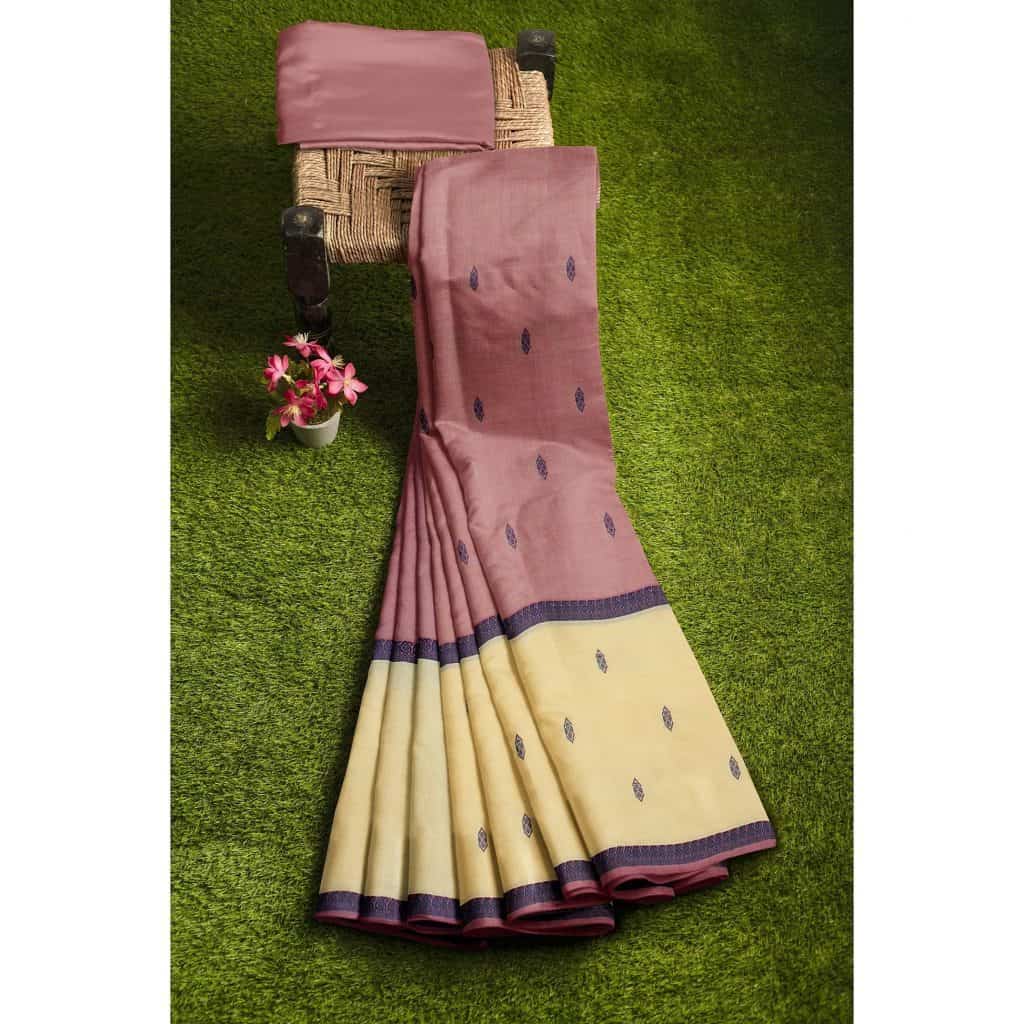
Art of Andhra Pradesh encompasses a rich tapestry of artistic expressions, spanning diverse mediums such as painting, sculpture, pottery, and textile arts like silk weaving. A hallmark of Indian art is its strong sense of design, evident in both its traditional and contemporary manifestations.
The roots of Indian art delve deep into antiquity, with evidence of artistic endeavours dating back to prehistoric settlements in the 3rd millennium BCE. Over the millennia, the Art of Andhra Pradesh has evolved, shaped by cultural, religious, and regional influences. Notably, sculpture in stone and metal, often depicting religious themes, has endured the test of time, offering glimpses into India’s rich artistic heritage.
Among the many regions renowned for their artistic prowess, Andhra Pradesh stands out as a veritable hub of creativity. Known for its delectable cuisine, including the famed biryani and haleem, Andhra Pradesh also boasts a distinctive tradition of craftsmanship, exemplified by the intricate art of Kondapalli wooden doll making and handloom weaving, among others. These crafts not only showcase the artisans’ skill and creativity but also serve as repositories of cultural heritage, preserving age-old techniques and traditions for posterity.
As we delve deeper into the artistic landscape of Andhra, we uncover a world where craftsmanship intertwines with cultural heritage, resulting in creations that captivate the senses and tell stories of a land steeped in tradition and innovation. Join us on a journey through the vibrant streets and workshops of Andhra Pradesh, where every brushstroke and weave speaks volumes about the enduring spirit of Indian artistry.
Kondapalli Dolls- Art of Andhra Pradesh
Located within the enchanting landscape of the Krishna district near Vijayawada, the age-old tradition of crafting Kondapalli toys continues to thrive, echoing the rich heritage and artistic prowess of the region. For centuries, artisans in the quaint Bommala Colony, aptly named Toys Colony, have meticulously preserved and passed down this cherished art form from generation to generation.
The legacy of Kondapalli toys spans over four centuries, deeply interwoven with the cultural fabric of Telugu society. Once renowned and cherished far beyond the borders of India, these toys hold a special place in the hearts of locals, their popularity transcending time and generations.
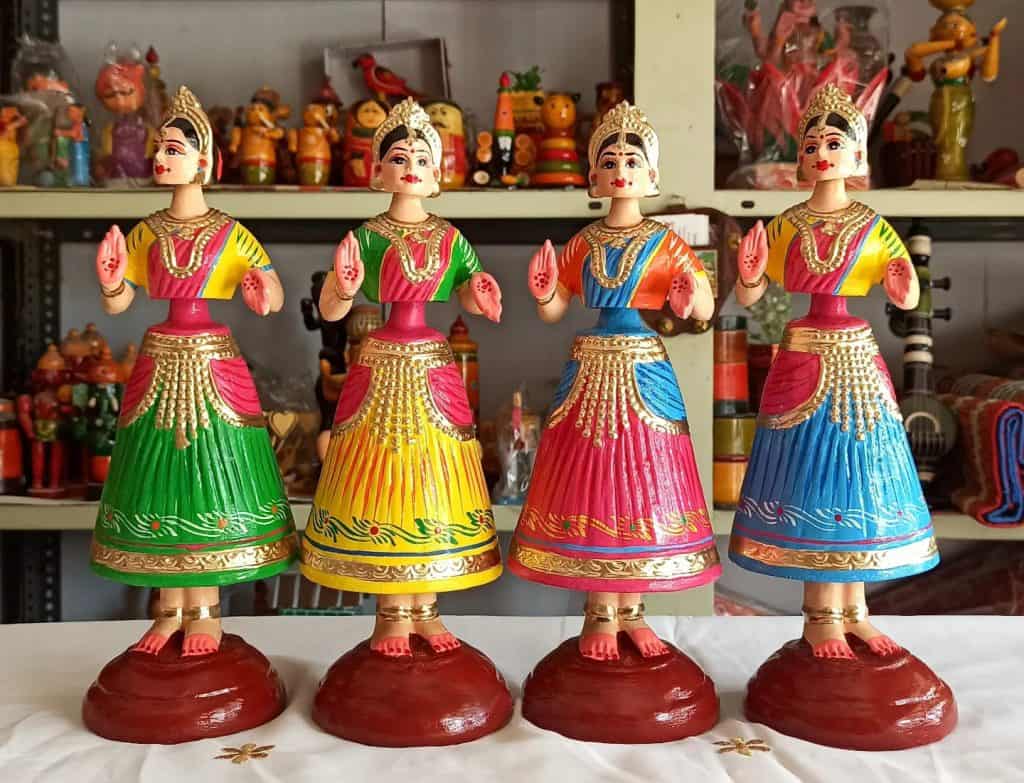
Legend has it that the roots of Kondapalli toy-making trace back to the ancient scriptures, with skilled artisans known as Aryakhastriyas or Nakarshalu, believed to have migrated to the region from Rajasthan in the 16th century. It is said that their craft was bestowed upon them by divine intervention, as they learned the art from the sage Muktharishi, blessed with artistic talents by Lord Shiva himself.
The process of creating Kondapalli toys is a labour of love and precision. Using softwood sourced from the nearby Kondapalli Hills, artisans meticulously carve each piece by hand, paying meticulous attention to detail. These individual pieces are then expertly assembled using a paste made from tamarind seed powder and sawdust known as makku.
The finishing touches involve adding intricate designs and vibrant colours, achieved through the use of oil, watercolours, or vegetable dyes. Each toy is not just a work of art but a testament to the craftsmanship, creativity, and cultural heritage of Andhra Pradesh, reflecting the enduring spirit of its artisans.
Handlooms- Art of Andhra Pradesh
The art of Andhra Pradesh has been celebrated since antiquity for its exquisite hand-woven textiles, a testament to the skill and artistry of its weavers. Among its most revered creations are the handwoven sarees, known for their unparalleled elegance and intricate designs. These sarees, adorned with richly woven ‘pallous’, showcase the mastery of Andhra’s weavers in creating timeless pieces of wearable art.
The borders of these sarees are often embellished with exquisite threadwork, typically crafted from precious metals such as gold or silver, adding a touch of opulence to the fabric. Each region in Andhra Pradesh boasts its unique style of handloom weaving, with distinct patterns, motifs, and weaving techniques that reflect the cultural heritage and traditions of the area.
Traditionally, Andhra Pradesh’s handloom industry primarily focused on producing fabrics woven from natural silk and cotton fibres. However, in response to changing consumer preferences and market demands, weavers have adapted their craft to create innovative blends of silk and cotton known as ‘cotton silk’ or ‘sico’. These hybrid fabrics combine the luxurious texture of silk with the comfort and durability of cotton, offering a versatile and modern alternative to traditional handwoven textiles.
The story of Andhra Pradesh’s handloom heritage is one of diversity and excellence, with various categories showcasing the best of the region’s weaving traditions. From the intricate designs of Kalamkari to the vibrant hues of Dharmavaram silk, each category represents a unique aspect of Andhra’s rich textile legacy, perpetuating centuries-old traditions while embracing innovation for the modern era.
Dharmavaram Silk Sarees- Art of Andhra Pradesh
Dharmavaram Silk sarees, hailing from Andhra Pradesh, are renowned for their superior craftsmanship, vivid hues, and classic charm, significantly contributing to the area’s cultural legacy. These sarees, originating from the town of Dharmavaram in the Anantapur district, boast a rich history of over 120 years, distinguished early on by their innovative dual-tone appearance, setting a new standard in ethnic fashion.
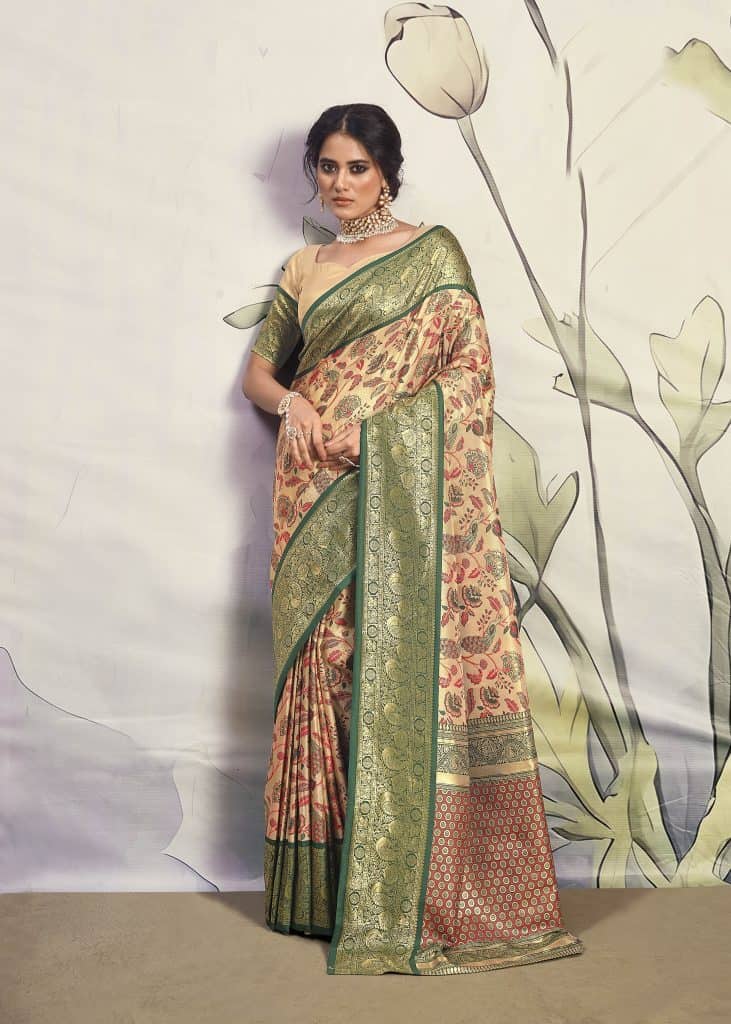
Crafted on handlooms using mulberry silk and zari, they feature elaborate borders, gradient pallus, and traditional patterns that capture Andhra Pradesh’s cultural depth. Over time, they’ve seamlessly integrated modern styles while retaining their heritage aesthetic, making them a favoured choice for weddings and festive occasions.
The creation of Dharmavaram Silk sarees demonstrates the local weavers’ extraordinary talent and commitment, a craft passed down through generations, enhancing its appeal both domestically and abroad.
Mangalagiri Silk Sarees- Art of Andhra Pradesh
Named after the picturesque village of Mangalagiri, nestled near Vijayawada, Mangalagiri sarees are renowned for their vibrant hues and minimalist elegance. Unlike many traditional sarees, Mangalagiri sarees eschew embellishments on the main body, focusing instead on their distinctive features: a striped golden pallu and intricate zari border. Their enduring popularity stems from their durability, crafted from smooth cotton with a simple yet timeless design, attracting admirers worldwide.
Mangalagiri sarees are crafted with meticulous attention to detail, typically woven using fine 80s combed cotton yarn for both warp and weft, with an additional warp design in the border, famously known as the “Nizam Border.” This unique design incorporates a blend of twill, rib, and diamond weaves, seamlessly arranged from the edge of the selvedge without interruption. Zari threads are intricately woven into the extra warp design, adding a touch of opulence to the saree.
Available in a plethora of resplendent colours and vibrant shot combinations, Mangalagiri sarees exude a timeless charm that transcends trends, making them a cherished addition to any wardrobe.
Venkatgiri Sarees- Art of Andhra Pradesh
Venkatagiri sarees, renowned for their exquisite craftsmanship, are predominantly fashioned from a blend of cotton and silk or pure silk, meticulously woven on traditional pit looms. This art of weaving, deeply rooted in the heritage of Venkatagiri, traces its origins back approximately 14 generations, believed to have commenced during the reign of the Venkatagiri Raja. Today, this timeless art of Andhra Pradesh engages approximately 70,000 individuals from the village, a testament to its enduring legacy.
To identify an authentic Venkatagiri saree, observe the unique zari embellishments along its borders and pallu. These sarees are crafted from high-quality cotton, known for their high thread count, which imparts a luxuriously soft and silky feel to the fabric.
Traditionally, members of the Padmashali community were primarily involved in this artisanal work, but over time, artisans from diverse backgrounds have embraced the craft. Spanning five generations, craftsmen have dedicated their lives to perfecting the art of Venkatagiri saree-making.
Situated in the quaint village of Venkatagiri within the Nellore district of Andhra Pradesh, the preference for raw materials has evolved over time. While cotton was previously favoured to suit climatic conditions, contemporary preferences lean towards pure silk, tailored to meet customer demands.
The production process involves sourcing raw materials from various regions across India, with cotton yarns procured from Coimbatore, silk yarns from Bangalore, zari from Surat, and dyestuffs from Chennai and Vijayawada. This amalgamation of materials from different corners of the country contributes to the unique charm and quality of Venkatagiri sarees.
Uppada Pattu Sarees- Art of Andhra Pradesh
Uppada Pattu Sarees, renowned for their distinctive craftsmanship, originate from Uppada, situated in the East Godavari district of Andhra Pradesh, near Kakinada. These sarees have their roots in the ancient art of Jamdani weaving, which dates back approximately 300 years in Bangladesh. However, with the decline of Jamdani weaving post the Industrial Revolution, artisans in Andhra Pradesh adapted these techniques to local designs and aesthetics, giving rise to the unique creation known as Uppada Pattu sarees.
In the creation of authentic Uppada sarees, silver zari is first immersed in liquid gold before being woven into the fabric. To recognize a genuine Uppada saree, one should examine the motifs on the reverse side, which should be as meticulously detailed as those on the front. The Uppada technique allows for an endless variety of patterns and designs, showcasing the versatility and skill of the weavers.
The intricate patterns and labour-intensive process are synonymous with woven textiles across the country, and Uppada Pattu Sarees are no exception. Each saree requires meticulous attention and can take anywhere from 10 to 60 days to complete, with artisans dedicating around 10 hours of labour each day to the weaving process.
The journey of creating a Uppada Pattu Saree begins with the meticulous planning of the weave on graph paper, followed by the weaving process where threads are meticulously arranged in a 100-count pattern. Working in pairs, two weavers collaborate on a single loom to intricately weave ornate patterns, often incorporating zari for added richness and elegance.
Tholu Bommalata (Leather Puppets)- Art of Andhra Pradesh
Tholu Bommalata, the leather puppet theatre originating from Andhra Pradesh, stands as a distinctive embodiment of both tangible and intangible cultural heritage within the art of Andhra Pradesh. Crafted from translucent goatskin, these puppets are notable for their grand size and vibrant hues.
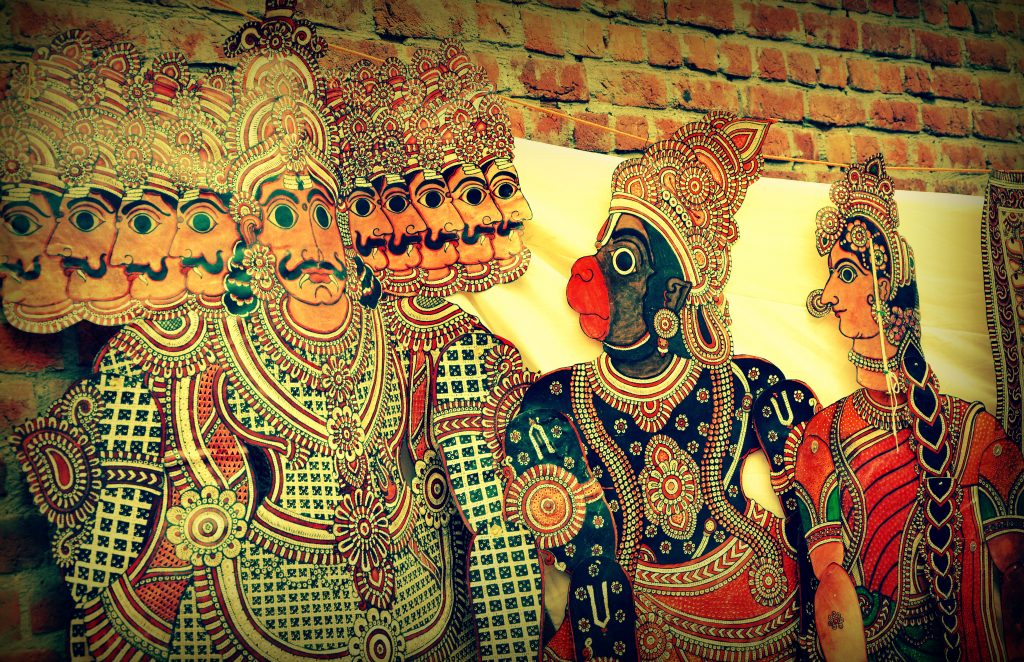
Each puppet is a masterpiece of intricate detailing, adorned with vibrant colours and delicate perforations, capturing the eye with its vivid presence. Locally known as Tholu Bommalata, this traditional art form traces its roots back to the 16th century, flourishing under the patronage of Vijayanagara rulers.
Legend has it that Tholu Bommalata has its origins in the ancient theatrical form known as “Chhaya Nataka” or shadow drama, believed to have originated in Gujarat around a millennium ago before spreading to Maharashtra. Over time, it migrated across different regions of India, evolving and flourishing along the way. Today, the tradition of shadow puppet theatre thrives in states like Karnataka, Andhra Pradesh, Kerala, Tamil Nadu, Maharashtra, and Odisha, each region adding its own unique cultural nuances to this age-old art form.
Budithi Brassware- Art of Andhra Pradesh
Andhra Pradesh boasts the distinctive Budithi art, a renowned form of metal handicrafts in India, originating from the Budithi village in the Srikakulam district. This art form is celebrated for its exquisite metalwork, blending traditional techniques with contemporary styles to produce stunning creations. The primary metal used in Budithi art is brass, known for its versatility and lustrous finish, which adds a timeless charm to the handicrafts.
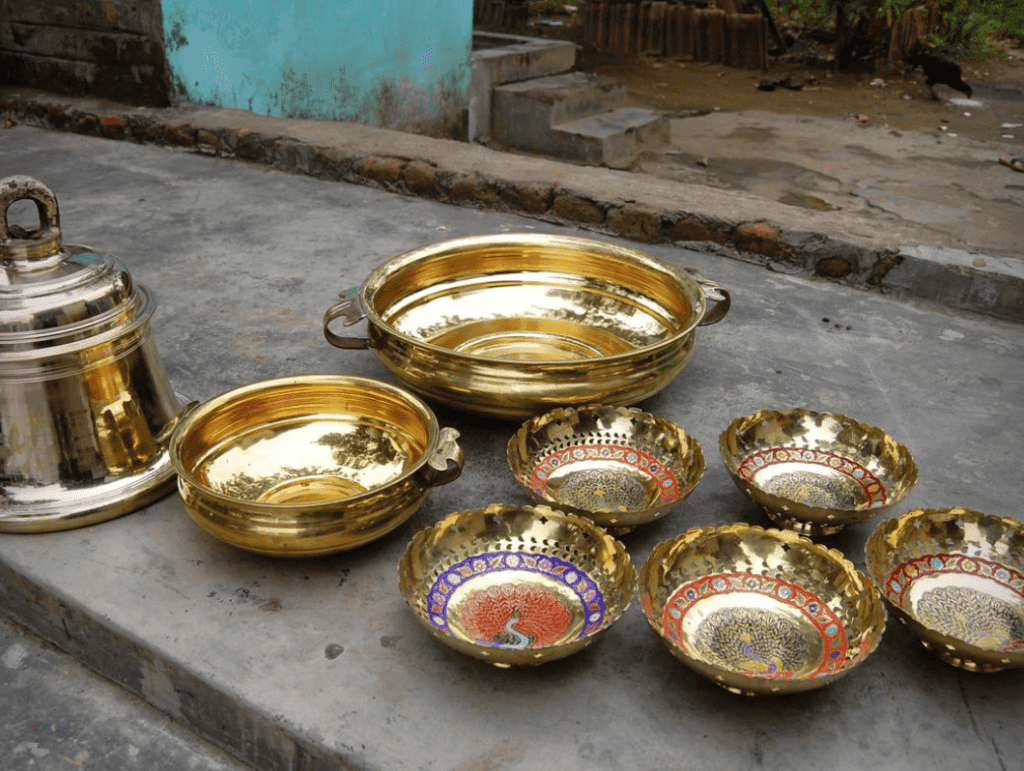
What was once a cherished tradition in the village has now evolved into a thriving profession for the locals, thanks to the patronage of the state government and increased recognition. The repertoire of Budithi art includes a variety of items such as Bindelu (water containers), flower vases, utensils, and more. Moreover, brass is also utilized for crafting statues of deities, household utensils, and decorative pieces, further diversifying the range of products.
The popularity of Budithi art continues to soar, with its products sought after by collectors and enthusiasts alike. The price of these exquisite creations varies depending on factors like quality and design intricacy, making them accessible to a wide range of consumers while ensuring that each piece remains a testament to the skilled craftsmanship of Andhra Pradesh.
Bobbili Veena- Art of Andhra Pradesh
Renowned as the ‘Bobbili Veena’, the traditional ‘Saraswati Veena’ hailing from Bobbili is celebrated for its melodious tunes and unique resonance. Crafted with meticulous care, these veenas are fashioned from logs of jackwood sourced from Gollapalli, a town in Bobbili. The process of transforming a mute wood log into a finely tuned musical instrument spans nearly a month. Jackwood, prized for its lightweight nature and distinct grain, is preferred for its ability to produce quality tones.
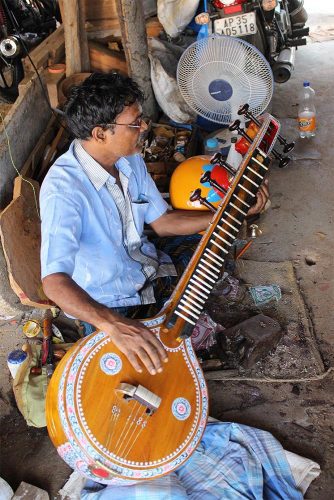
The selection of wood is crucial, considering factors like thickness and strength, which contribute to the instrument’s overall quality. Known as ‘Ekandi Veena’, each instrument is carved from a single piece of wood, ensuring unity and resonance in sound production. These Veenas also stand out for their intricate designs adorning the body, adding to their exclusivity.
Dating back to the Seventeenth Century, Bobbili Veenas are played in a distinctive style, giving rise to the ‘Bobbili Veena Sampradayam’. Additionally, miniature versions of these Veenas, crafted with the same materials and attention to detail as their larger counterparts, serve as excellent options for gifts and collector’s items.
Udayagiri wooden cutlery- Art of Andhra Pradesh
The exquisite Udayagiri wooden cutlery stands as a testament to the transformative power of art, elevating the ordinary into objects of beauty and functionality. Crafted with precision, this collection from the Art of Andhra Pradesh includes finely carved spoons, forks, knives, and bowls, merging utility with ornamental allure. It’s a testimony to the notion that even the simplest tools of everyday life can be turned into regal pieces that enhance dining experiences.
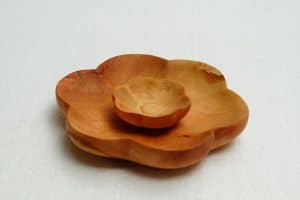
Udayagiri, situated in the Nellore district of Andhra Pradesh, has a rich history dating back to the 14th century when it was ruled by the Gajapatis of Odisha. The tradition of Udayagiri wooden cutlery emerged from the skilled hands of local artisans, nurtured under the patronage of royal families in the region.
Adorned with Persian-inspired motifs, the wooden cutlery reflects a blend of cultural influences and artistic ingenuity. This craft, spanning over 150 years, has been carefully passed down from one generation of artisans to the next. While traditionally a male-dominated craft, in recent years, more females have become involved in the design and development of these elegant creations, further enriching the legacy of Udayagiri wooden cutlery.
From vibrant textiles to detailed paintings and unique pottery, these crafts are not just products, but stories woven into the very fabric of Andhra’s culture. Let the art of Andhra Pradesh inspire you to explore further, appreciate the beauty in craftsmanship, and recognize the incredible diversity of India’s artistic heritage.
Read more: Latest



